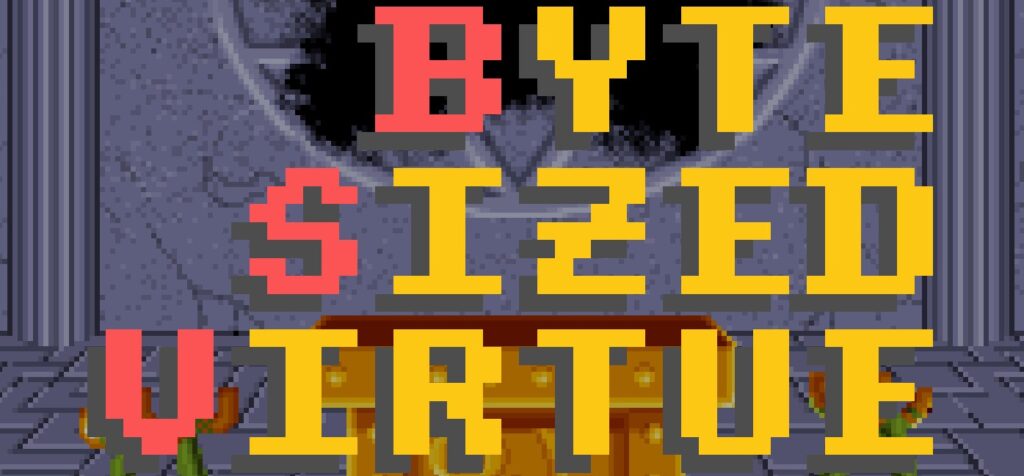Byte-Sized Virtue: Episode 4 – Justice and Christmas

It being Advent, I find myself moved once more to muse upon matters philosophical, examining the Eight Virtues of the Ultima series and comparing these against real-world philosophy and theology. This year, I’d like to focus on the Virtue of Justice, which I don’t think I’ve given much attention to in years past.
Listen to the Episode
When I first set upon the idea of discussing the Virtue of Justice during Advent, and over the Christmas season, a few people expressed doubts about how I would be able to really tie the virtue in with Christmas proper. At least on the surface of it, the connection doesn’t seem obvious. I mean, we catch the occasional glimpse of the concept in e.g. the lyrics of Christmas carols (e.g. “Hark the herald angels sing glory to the newborn King. Peace on Earth, and mercy mild; God and sinners reconciled.”), but for the most part the idea of Justice isn’t the first — or even the third — thing to spring to mind when one stops to contemplate the mysteries of Christmas.
But in fact, there is a rather profound connection between Christmas and Justice…the real-world virtue, especially. However, while it doesn’t take a lot to explain (actually, I found it to be a rather easy connection to make; this episode took a quarter of the time to research and draft as did any of the others), it is a very theological explanation; simply scratching the surface of the relevant philosophy isn’t sufficient to our purposes.
So if Catholic exegesis isn’t your thing…well, I’ll see you next week.
Science fiction author John C. Wright put together a collection of short science fiction and fantasy stories that centered on the theme of Christmas. (No, really; The Book of Feasts and Seasons has a number of truly excellent stories in it; I highly recommend it.) In one story, Nativity, a grieving widower goes back in time to just after the night of Jesus’ birth, and after avoiding an assassination attempt by agents of a trans-temporal agency that acts quickly to reverse disruptions in the flow of time (yes, really), he ends up walking into the stable — really, a cave in a hillside — in which the Holy Family is, for the moment, residing. And there’s this one paragraph in which the meeting with Mary is described:
“I wish I could tell you how pretty she was. Her eyes were calm as a sea which had never known a storm, never felt the slightest wind, but were clear and blue deep into infinite deeps. It was like looking at the crystal bar of the time machine, as if they opened into another dimension. It was like — how can I put this? — as if I were Tarzan and had been raised by apes and was seeing a real human being, a normal human being a woman who looked just like the way women were designed to look from the beginning, seeing one for the first time.”
This idea — that, to a wholly average human being (apart from the time travel bit), Mary seemed somehow more genuinely human, as a normal human might seem to one raised by apes — is not a new concept that Mr. Wright invented for the purpose of telling a story. It’s actually very mainstream Christian theology, the understanding that we become more fully human by entering into the life of total, self-giving love that flows from the redemptive gift offered to each of us by Jesus. (I’ll have to leave aside the discussion of Mary’s status as being preserved from sin in order to keep this episode brief, although that too is part of this understanding. Like as not, being sinless, Mary would probably have seemed somehow different as compared to other women — or men! — of her day.)
And that’s actually where Justice comes in.
Here’s another theological concept: original justice. Broadly defined, it is the state that humanity occupied before sin entered into the world; “[i]t was the simultaneous possession [of] sanctifying grace, with its right to enter heaven, and the preternatural gifts. Had [humanity] not sinned, original justice would have been transmitted to all [of its] descendants.”
Sanctifying grace, in this consideration, is the ultimate due of humanity, one which — theologically speaking — humanity deprived itself of. In this way, then, the whole of human existence can be thought of as being somehow operating under a profound injustice, through mankind’s incapacity to restore itself to a state of being originally just, of being sanctified.
Christmas, then, represents the beginning of the way in which that which is our due is restored to us. “Jesus Christ, the new head of the human race, by his passion and death expiated human sin and regained what [humanity] had lost. Sanctifying grace is restored at justification, but the preternatural gifts are returned only as capacities (such as the ability to overcome concupiscence) or only eventually (such as bodily immortality after the final resurrection).”
The Christmas story can thus be thought of as representing, really, the first in a number of acts of special justice which have, as their ultimate end, the goal of seeing humanity given back that which is its due…not in any temporal sense, but in eternity. The story of Jesus — His birth, His life, and even His death — is a story of Justice, and then one in which things which seem profoundly unjust — from the impoverished circumstances of Jesus’ birth to the vicious nature of His death — are actually made into the means by which Justice is effected, and humanity’s due restored.















































